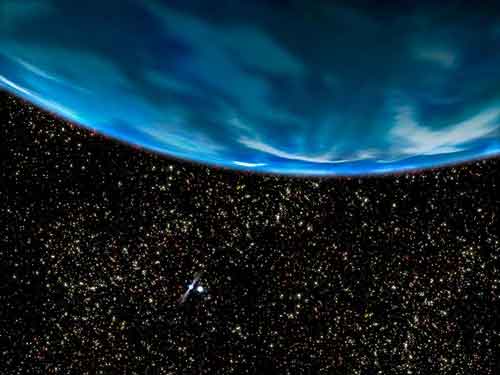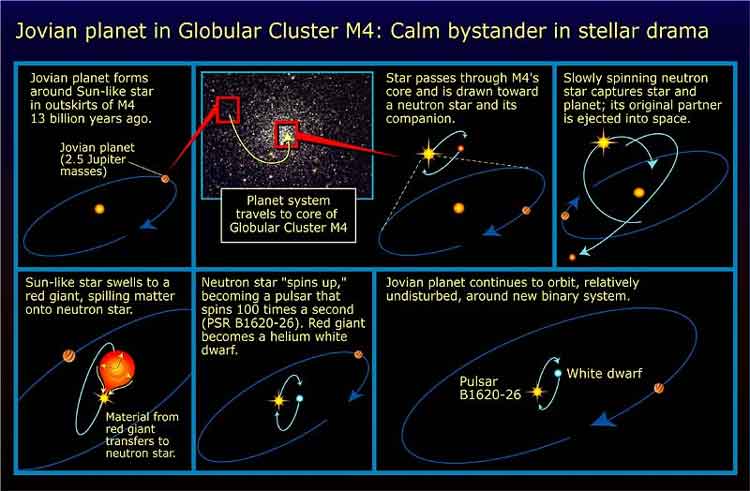- ^ Britt, Robert Roy. Primeval Planet: Oldest Known World Conjures Prospect of Ancient Life. Space.com. Retrieved on 2007-06-12.
- ^ Notes for star PSR B1620-26. The Extrasolar Planets Encyclopaedia. Retrieved on 2006-05-07.
- ^ Thorsett, S.E.; Arzoumanian, Z.; Taylor, J.H. (1993). "PSR B1620-26 - A binary radio pulsar with a planetary companion?". Astrophysical Journal Letters 412 (1): L33 – L36. doi:10.1086/186933.
- ^ a b Sigurdsson, S.; Richer, H.B.; Hansen, B.M.; Stairs I.H.; Thorsett, S.E. (2003). "A Young White Dwarf Companion to Pulsar B1620-26: Evidence for Early Planet Formation". Science 301 (5630): 193 – 196. doi:10.1126/science.1086326.
- ^ Oldest Known Planet Identified. HubbleSite. Retrieved on 2006-05-07.
- ^ Ford, E.B., Joshi, K.J., Rasio, F.A., Zbarsky, B. (2000). "Theoretical Implications of the PSR B1620-26 Triple System and its Planet". The Astrophysical Journal 528: 336 – 350. doi:10.1086/308167. (preprint)
|
Artist's impression of PSR B1620-26c looking at its suns., Illustration Credit: NASA and G. Bacon
PSR B1620-26c or PSR B1620-26b (the issue of naming is covered in PSR B1620-26) is an extrasolar planet orbiting the millisecond pulsar PSR B1620-26 in the globular cluster M4, about 12,400 light-years away in the constellation of Scorpius. The planet is the oldest known extrasolar planet. It is believed to be about 12.7 billion years old.[1] The PSR B1620-26 system PSR B1620-26c orbits a binary pair of stars. One, the pulsar, is a neutron star spinning at 100 revolutions per second. The second is a white dwarf with a mass of 0.34 solar mass. These stars orbit each other at a distance of 1 AU about once every six months. As the third object found in the system, the planet's official designation is PSR B1620-26c. The planet has a mass of 2.5 times that of Jupiter, and orbits at a distance of 23 AU (3400 million km), a little larger than the distance between Uranus and the Sun. Each orbit of the planet takes about 100 years. [2] The triple system is just outside the core of the globular cluster M4. The age of the cluster has been estimated to be about 12.7 billion years, and because all stars in a cluster form at about the same time, and planets form together with their host stars, it is likely that PSR B1620-26c is also about 12.7 billion years old. This is much older than any other known planet, and nearly three times as old as Earth. The nickname "Methuselah" was given as a reference to the long-lived Biblical Methuselah. However, this name is not generally used in the astronomical literature, and has not been accepted by the International Astronomical Union, which governs the naming of astronomical objects. Discovery of PSR B1620-26c Like nearly all extrasolar planets discovered to date, PSR B1620-26c was originally detected through the Doppler shifts its orbit induces on radiation from the star it orbits (in this case, changes in the apparent pulsation period of the pulsar). In the early 1990s, a group of astronomers led by Donald Backer, were studying what they thought was a binary pulsar, determined that a third object was needed to explain the observed Doppler shifts. Within a few years, the gravitational effects of the planet on the orbit of the pulsar and white dwarf had been measured, giving an estimate of the mass of the third object that was too small for it to be a star. The conclusion that the third object was a planet was announced by Stephen Thorsett and his collaborators in 1993. [3] The study of the planetary orbit allowed the mass of the white dwarf star to be estimated as well, and theories of the formation of the planet suggested that the white dwarf should be young and hot. On July 10, 2003, the detection of the white dwarf and confirmation of its predicted properties were announced by a team led by Steinn Sigurdsson, using observations from the Hubble Space Telescope. It was at a NASA press briefing that the name Methuselah was introduced, capturing press attention around the world. [4] [5] Evolutionary history
The evolution of the PSR B1620-26 system. The origin of this pulsar planet is still uncertain, but it probably did not form where we see it today. Because of the decreased gravitational force when the core of star collapses to a neutron star and ejects most of its mass in a supernova explosion, it is unlikely that a planet could remain in orbit after such an event. It is more likely that the planet formed in orbit around the star that has now evolved into the white dwarf, and that the star and planet were only later captured into orbit around the neutron star. [4] [6] Stellar encounters are not very common in the disk of the Milky Way, where our Sun lives, but in the dense core of globular clusters they occur frequently. At some point during the 10 billion years, the neutron star is thought to have encountered and captured the host star of the planet into a tight orbit, probably losing a previous companion star in the process. About half a billion years ago, the newly captured star began to expand into a red giant (see stellar evolution). Typical pulsar periods for young pulsars are of the order one second, and they increase with time; the very short periods exhibited by so-called millisecond pulsars are due to the transfer of material from a binary companion. The pulse period of PSR B1620-26 is a few milliseconds, providing strong evidence for matter transfer. It is believed that as the pulsar's red giant companion expanded, it filled and then exceeded its Roche lobe, so that its surface layers started being transferred onto the neutron star. The infalling matter produced complex and spectacular effects. The infalling matter 'spun up' the neutron star, due to the transfer of angular momentum, and for a few hundred million years, the stars formed a low-mass X-ray binary, as the infalling matter was heated to temperatures high enough to glow in X-rays. Mass transfer came to an end when the surface layers of the mass-losing star were depleted, and the core slowly shrunk to a white dwarf. Now the stars peacefully orbit around each other. The long-term prospects for PSR B1620-26 c are poor, though. The triple system, which is much more massive than a typical isolated star in M4, is slowly drifting down into the core of the cluster, where the density of stars is very high. In a billion years or so, the triple will probably have another close encounter with a nearby star. The most common outcome of such encounters is that the lightest companion is ejected from the multiple star system. If this happens, PSR B1620-26c will most likely be ejected completely from M4, and will spend the rest of its existence wandering alone in interstellar space as an interstellar planet. See also * 51 Pegasi b References
Links
Retrieved from "http://en.wikipedia.org/"

|
|
|||||||||||||||||||||||||||||||||||||||||||||||||||||||||||||||||||||||||||||||||||||


